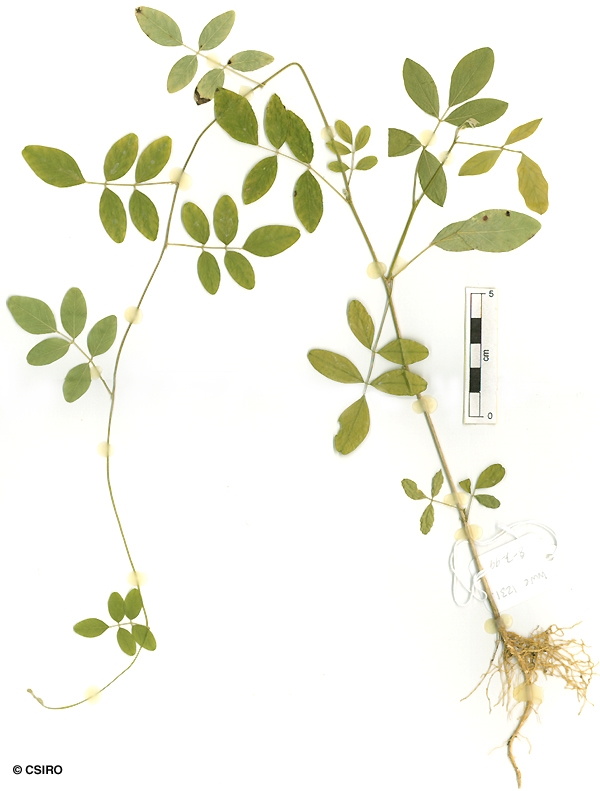Australian Tropical Rainforest Plants - Online edition
Clitoria ternatea L.





Linnaeus, C. von (1753) Species Plantarum 2: 753. Type: Habitat in India.
Pea, Blue; Queen's Shoe; Bluebell-vine; Darwin Pea; Butterfly Pea; Blue Pea; Cordofan Pea; Pea, Darwin; Pea, Butterfly; Pea, Cordofan
A slender vine not exceeding a stem diameter of 2 cm.
Compound leaves with five to seven leaflets. Leaflet blades about 25-42 x 13-25 mm, the terminal leaflet larger than the laterals. Lateral leaflet stalks about 2 mm long, terminal leaflet stalk about 9-13 mm long. Lateral veins about 6 or 7 on each side of the midrib. Stipules hairy, about 5 mm long, elliptic, venation longitudinal and parallel. Stipels about 1-1.25 mm long. Upper and lower leaflet blade surfaces clothed in prostrate white hairs.
Flowers about 30 mm diam., inverted on the plant, each flower subtended by 2 pale green leafy bracts about 10-11 x 7-10 mm. Each flower stalk subtended by two smaller leafy bracts. Calyx tube about 9-13 mm long, lobes unequal in length, about 5-9 mm long. Petals: standard large, about 30-50 mm long, deep blue except for yellow green markings; wings mostly deep blue, about 25 mm long; keel pale green, about 25 mm long. Stamens 10, the filaments of nine stamens fused to form a tube about 7-10 mm long, open on one side. Free part of the filaments alternately long and short. One stamen free. Anthers on the longer filaments basifixed, anthers on the shorter filaments dorsifixed. Ovary elongated, about 10 mm long, densely clothed in white hairs. Style + stigma about 11-12 mm long. Ovules 10-12.
Cotyledons glabrous, elliptic, asymmetrical, about 18-26 x 11-18 mm, both cotyledons indented on one margin. Venation variable, either penninerved to with 3-5 veins radiating from the base. First pair of leaves simple, elliptic, upper and lower surfaces clothed in hairs. Midrib raised on the upper surface. Stipules linear, about 2-3 mm long. Third leaf trifoliolate. At the tenth leaf stage: leaf pinnate with 5 leaflets. Leaflet blades elliptic, apex retuse, mucronate, the mucro often reflexed, base cuneate-obtuse. Upper and lower leaflet blade surfaces clothed in appressed pale hairs. Midrib +/- flush with the upper surface. Stalk of the terminal leaflet pulvinate and longer than those on the lateral leaflets. Stipules oblong-lanceolate, about 3 mm long, hairy. Stipels present. Plants twining. Seed germination time 17 to 455 days.
An introduced species of uncertain origin. Occurs in WA, NT, CYP, NEQ, CEQ and southwards almost to south-eastern Queensland. Altitudinal range from near sea level to 500 m. Usually grows in open forest but sometimes on the margin of rain forest and monsoon forest. Also occurs in Asia and Malesia, generally regarded as being pantropic.
This species has been used medicinally in India and the Philippines. Cribb (1981).
This species is palatable and nutritious to stock. A potentially useful plant on tropical clay soils; sensitive to frost. Pods are sometimes eaten by humans in the Philippines. The root is an effective purgative. Hacker (1990).





